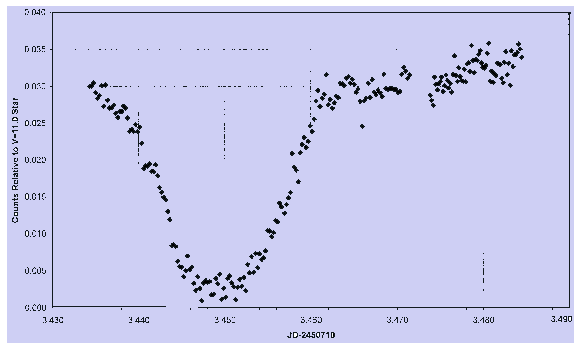
J. Brit. Astron. Assoc., 110, 2, 2000, p.104
On 1999 October 11 the deeply-eclipsing dwarf nova IP Pegasi went into outburst, reaching visual magnitude 12.5 about 2 days later. On average it does this every 95 days, but only in the late summer or early autumn is it above the horizon for long enough at night to allow observing runs measured in hours. Each year between 1994 and the present it has been observed in outburst at this time of year by professionals at Keele Observatory using a 0.6m reflector and ST-6 CCD system, and by amateurs in the UK and elsewhere using visual and CCD techniques.[1]
Why has so much observing effort been devoted to IP Peg? It is one of the few dwarf novae known to exhibit eclipses, which occur when the angle of inclination between the polar axis of the system and the line of sight to the observer is sufficiently high (above ~70°) that the secondary star in the system passes in front of the accretion disc in the course of orbital motion. For angles of inclination above ~80° the eclipses may be more than a magnitude deep, and the white dwarf primary star eclipsed as well as the disc. Thus in any eclipsing dwarf nova an eclipse light curve can reveal important information about the accretion disc, e.g. its outside diameter, its radial brightness distribution, the presence and characteristics of any bright spot (due to the accretion stream from the secondary star hitting the disc) and so on. A series of such light curves can show how the disc is changing with time. In particular, eclipses observed at the start of an outburst can help determine the mechanism responsible for the outburst.
According to currently accepted 'disc instability' theory, dwarf nova outbursts occur when, in normal (quiescent state) accretion, the surface density and temperature of the disc reach an unstable state; the temperature and radiation level then rise quickly and material stored in the disc is dumped onto the primary star. Depending on system parameters (e.g. orbital period, diameter of the secondary etc) and possibly on its recent history, disc heating may begin either at the outer or inner edge, thus giving rise respectively to either 'outside-in' or 'inside-out' outbursts. An important challenge for both observers and theoreticians is to determine which of these is occurring in a particular system. If the system is eclipsing, an outside-in outburst will typically reveal itself through initially wide, shallow eclipses, while an inside-out outburst will produce initially deep, narrow eclipses. Theory predicts that outside-in outbursts develop more quickly than inside-out outbursts, so that if both types occur in a given star fast-rise outbursts should be outside-in and slower-rise outbursts inside-out.

With an orbital inclination of 81° and moderately frequent outbursts, IP Peg is an ideal target for investigation in terms of the above discussion. The figure shows a V-band eclipse light curve taken at Keele at the start of the September 1997 outburst; the light level is displayed in intensity units rather than magnitudes to make interpretation easier. This curve is deep and narrow like a quiescent eclipse light curve except that the background light level just after the eclipse is higher than in quiescence. This signifies an inside-out outburst. Later eclipses in the same outburst were wider and shallower near the peak of outburst, reverting to the deeper, narrower form in the decline phase. The rise time for this outburst was between three and four days, i.e. relatively long. The combination of long rise time and inside-out outburst development is exactly as expected theoretically.
If the entire set of outburst observations over the period 1994-1999 is considered, it is clear that a range of rise times is represented, from one day in 1996 September and less than two days in 1994 August and 1999 October, to 3-4 days in 1997. However apart from outbursts for which the coverage was insufficient to determine the direction of development (1995 and 1998), the direction was inside-out in all cases. To date there are no outbursts of IP Peg on BAAVSS records for which outside-in development is indicated by the observations. The fact that this result does not entirely square with theoretical expectations suggests the importance of the data collected in this project. Both visual and CCD observers should be encouraged to continue their work on outbursts of IP Peg to see whether these results are strengthened in future, or whether the star displays a richer variety of behaviour than seen hitherto.
W. J. Worraker
[bill.worraker@hyprotech.com]
Reference:
[1] Webb N. A., Worraker W. J., James N. D., Strange D. et al., 'A spatially resolved 'inside-out' outburst of IP Pegasi', MNRAS, 310(2), 407-413, 1999
 Go to the BAA Journal home page
Go to the BAA Journal home page
Return to Journal 2000 April contents page